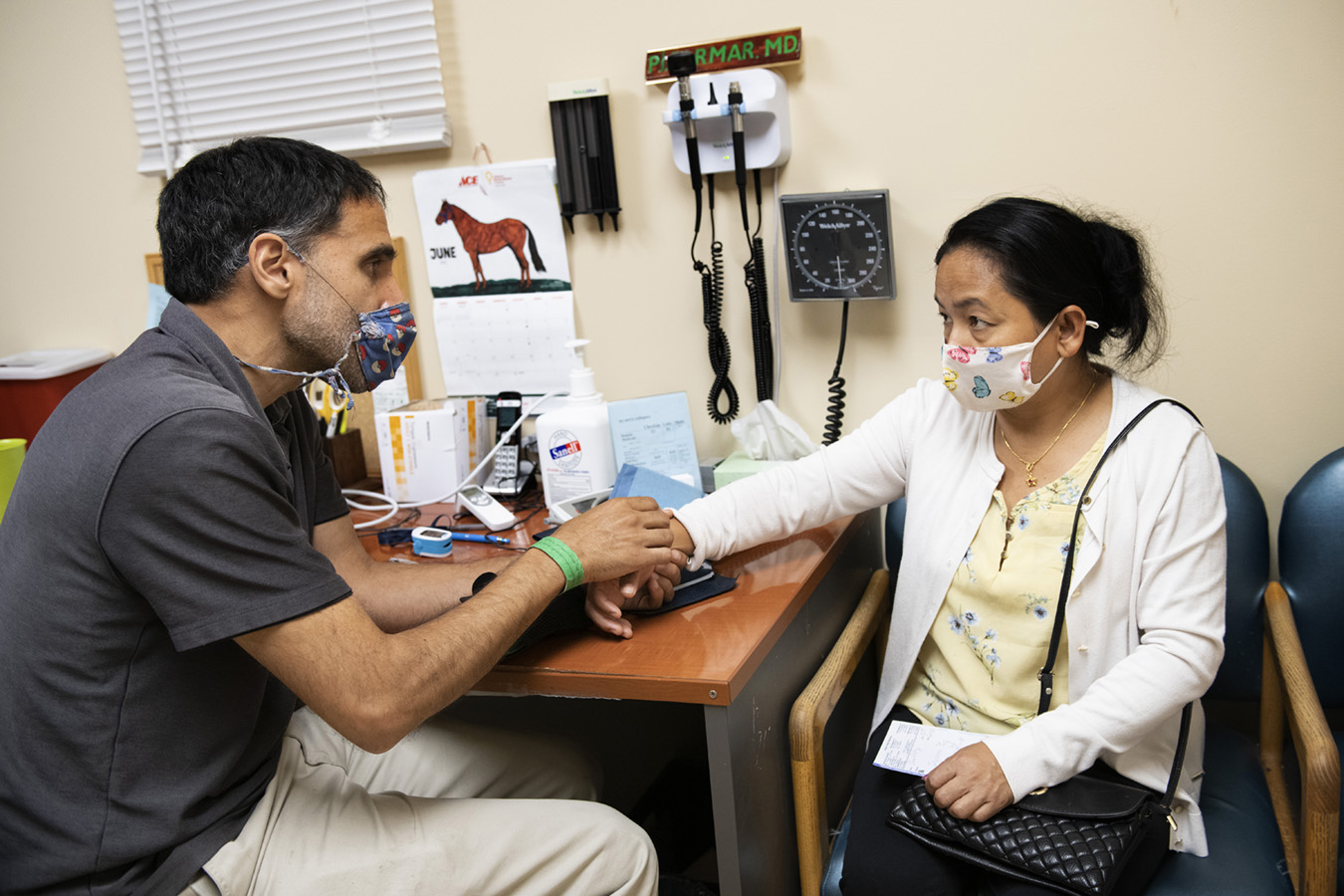SACRAMENTO, Calif. — Californians upset with Gov. Gavin Newsom’s pandemic rules — which shuttered businesses, kept schoolkids at home and mandated masks — helped fuel the September recall election that could spell the end of his political career.
But among the allies rushing to Newsom’s defense are doctors, nurses, dentists and other health care interests who credit those pandemic measures for protecting them as front-line workers and saving the lives of countless Californians.
Their unions and trade associations have written checks totaling more than $4.8 million as of 10 a.m. Friday to keep the first-term Democrat in office, according to a KHN analysis of campaign finance filings with the California secretary of state’s office.
Even before covid-19, Newsom had been a steadfast health care advocate and ally, adopting policies that expanded health benefits and coverage to hundreds of thousands of Californians — and lined the pockets of the industry in the process.
“He’s done so much so broadly within the health care sector in California to the benefit of patients and providers of all sorts,” said Andrew Kelly, an assistant professor in the Department of Health Sciences at California State University-East Bay. “That is good for the health care business, as well as our community — improving access to care and outcomes.”
Californians will decide Sept. 14 whether to recall Newsom on a ballot that also asks them to pick his replacement from a list of 46 candidates. If more than 50% of voters choose “yes” to recall Newsom, the candidate who wins the most votes will replace him.
The recall election offers Republicans in blue California — where Democrats hold all statewide offices and control the legislature — their best shot at winning the governor’s office. The GOP candidates with the highest name recognition are businessman John Cox, conservative talk show host Larry Elder, former San Diego Mayor Kevin Faulconer, reality TV star and former Olympian Caitlyn Jenner, suburban Sacramento state Assembly member Kevin Kiley and former congressman Doug Ose.
A poll released Tuesday by the University of California-Berkeley Institute of Governmental Studies found that 47% of likely voters said they favor recalling Newsom, compared with 50% who said they oppose recalling the governor.
Newsom’s supporters have given more than $40 million to fight the recall, compared with nearly $12 million by recall backers, which includes $5 million from Cox for his own campaign.
The health care contributions to fight the recall make up a fraction of the total, but they’re far-reaching: Health care worker unions, dentists, physicians, pharmacists, insurance companies, at least one hospital and others have made big contributions to independent campaign committees created by Newsom’s supporters that can accept unlimited donations.
The health care group that has given the most — $2.25 million — is the union representing California’s nursing home workers and in-home caregivers, Service Employees International Union 2015. Other contributions included $150,000 from the Union of American Physicians and Dentists (whose members include doctors and dentists employed by the state and some counties) and $500,000 from the California Dental Association. These groups either declined telephone interviews or did not respond to requests for comment.
In an emailed statement, SEIU 2015 did not address its sizable contributions but said it intended to mobilize “our mostly black, brown and immigrant caregivers who have been on the front lines of this pandemic to make their voices heard as we go door-to-door, over the phone and online encouraging a vote against the recall.”
An emailed statement from the California Dental Association said its political action committee “puts a great deal of consideration into supporting candidates who are interested in solving the challenges experienced by the dental profession and their patients.”
Republican candidates haven’t received any big donations — defined by the California Fair Political Practices Commission as $1,000 or more — from organized health care groups, which gubernatorial hopeful Kiley said shows just how cozy the governor is with the industry.
“You have vested interests that do whatever it takes to get the governor to do what they want,” said Kiley, one of two Assembly members who sued Newsom last year for using his emergency powers during a pandemic. “He’s taking money from all of them.”
The diverse field of health care interests defending Newsom aren’t always on the same side politically. In fact, they’re often at odds.
But if you’re in health care or public health, the prospect of Newsom being booted from office is worrisome, especially if you want the state to continue combating the pandemic, said Mark Peterson, a professor of public policy and political science at UCLA.
“I don’t think anyone who would be replacing the governor in the recall would be anywhere near as aggressive and might actually put in reverse the public health actions that have been taken,” Peterson said.
Sal Rosselli, president of the National Union of Healthcare Workers, which represents nurses, drug rehab counselors, pharmacists and others, said his union’s 15,000 members are grateful for Newsom’s leadership in the pandemic — citing his first-in-the-nation statewide stay-at-home order, his directive to hospitals last winter to test workers for covid, and other workplace orders that protected essential workers.
“These are all examples of real leadership,” Rosselli said.
In January, the union created a ballot committee to urge Californians not to sign the recall petition — chipping in just over $100,000 of its own money and collecting $10,000 apiece from state Senate leader Toni Atkins and Assembly Speaker Anthony Rendon, among others, to help pay for political ads praising Newsom’s leadership during the pandemic.
Nathan Click, a Newsom campaign spokesperson, did not address the money Newsom has received from the health care industry, but said Californians have a clear choice for governor.
“On one side, you have a governor who has expanded health care for Californians and fought to lower health care costs for families,” Click said via email. “On the other side are a bunch of Trump lackeys who want to repeal Obamacare and take away health care from those who need it most.”
When Newsom campaigned for governor in 2018, he called for a government-backed, single-payer health system at a time when the Trump administration and many Republican lawmakers were trying to dismantle the Affordable Care Act.
He hasn’t delivered on his single-payer pledge, citing insurmountable federal hurdles. But he has signed legislation and advocated for policies that insured more Californians or boosted their benefits, policies that also enrich insurers and providers by bringing them more patients.
For instance, low-income undocumented immigrants ages 19 to 25 became eligible for full benefits under Medi-Cal, California’s Medicaid program for poor residents, last year. Next year, people 50 and older will become eligible regardless of their immigration status.
For the more than 13 million Californians already in the program, Newsom and legislators agreed last year to restore dental, vision and other optional health care benefits that had been cut during the Great Recession. And they boosted the rates the program pays physicians and dentists.
Qualified Californians can also tap into state subsidies to reduce the cost of health insurance premiums sold through Covered California, a benefit approved by Newsom in 2019.
The recall has handed the unions an opportunity to pressure Newsom to act on his single-payer pledge, arguing that the pandemic has laid bare deadly disparities in health care. For example, Latinos in California not only were exposed to covid at much higher rates but also died at 1.5 times the rate of white Californians, according to researchers at Stanford University.
“We trust that Gavin Newsom is the person to lead” on single-payer, said Rosselli, who has known Newsom since he got into politics nearly 20 years ago. “To make California the first state in the nation as an example for the rest of the country on ending these inequities in health care.”
Methodology
Gov. Gavin Newsom is facing a recall election Sept. 14. To find out which health care interests are contributing for and against the recall effort, KHN analyzed campaign finance reports filed with the California secretary of state’s office through 10 a.m. Friday, July 30. Each candidate and campaign committee participating in the recall is required to report how much money they’ve raised and spent. Any donation of $1,000 or more must be reported within 24 hours.
We downloaded and analyzed campaign records from two committees created to support the recall, committees run by the leading Republican candidates, and five committees created to oppose the recall.
This story was produced by KHN, which publishes California Healthline, an editorially independent service of the California Health Care Foundation.
KHN (Kaiser Health News) is a national newsroom that produces in-depth journalism about health issues. Together with Policy Analysis and Polling, KHN is one of the three major operating programs at KFF (Kaiser Family Foundation). KFF is an endowed nonprofit organization providing information on health issues to the nation.
USE OUR CONTENT
This story can be republished for free (details).
from Health Industry – Kaiser Health News



